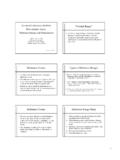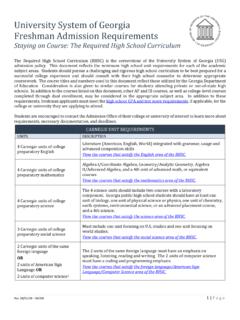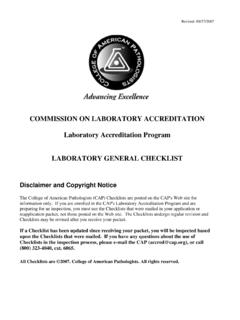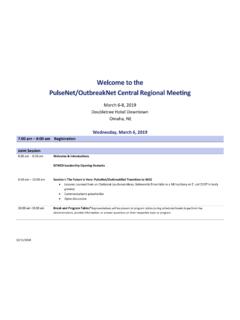Transcription of CLIA Individualized Quality Control Plan
1 CLIAI ndividualized Quality Control PlanWHAT IS AN IQCP?NOVEMBER 2014 OVERVIEWD iscovering, Deciphering and Designing an Individualized Quality Control plan (IQCP)IQCP provides a framework for customizing a Quality Control (QC) program for your test systems and your laboratory s unique environment. By performing the steps in an IQCP, you will examine the potential sources of error in your pre-analytic, analytic and post analytic phases of testing, as well as establish the appropriate QC and Quality practices which reduce the likelihood of errors occurring in your laboratory . After you complete this process, it is possible that you may determine that the amount of QC you have been doing all along is sufficient to achieve clia compliance. However, you could discover potential sources of error that you had not previously considered, and may need to implement additional QC activities. In either case you will have created a comprehensive QC program, which reflects your laboratory s unique operation, and the documentation which supports the rationale for your QC practices to ensure high Quality are the parts of an IQCP?
2 An IQCP requires: Risk Assessment (RA) Quality Control plan (QCP) Quality Assessment (QA)SECTION 1: IQCP RISK ASSESSMENTWHAT IS RISK ASSESSMENT (RA?)Risk Assessment is the means of identifying and evaluating potential problems or errors that may occur in your testing process. The testing process begins with the specimen collection (preanalytic) and continues through the analysis of the specimen (analytic) until the final test result is reported (postanalytic).12 WHAT ARE THE COMPONENTS OF A RISK ASSESSMENT (RA)?There are five components you must evaluate in your Risk Assessment (RA): Specimen Test System Reagents Environment Testing Personnel Consider the potential errors that might be attributable to these five components in your testing : You must evaluate these five components when performing your RA.
3 However, you may identify additional risk factors to consider and are not limited to just these five CAN I FIND RESOURCES FOR INFORMATION FOR CONDUCTING A RA?The following list contains possible sources of information for conducting a risk assessment: Regulatory requirements Manufacturer s package insert (including intended use, limitations, environmental requirements, QC frequency, specimen requirements, reagent storage, maintenance, calibration, interfering substances, etc.) Manufacturer s operator manual Troubleshooting guide Manufacturer s alerts and bulletins Verification or establishment of performance specifications Testing personnel qualifications, training, and competency records QC data Proficiency testing data QA information, including corrective action Scientific publications Other information as appropriate 3 WHAT ARE SOME POTENTIAL SOURCES OF ERROR FOR THE FIVE RACOMPONENTS?To discover those unique features of your program, and decipher what their impact is in your laboratory , below is a general list of potential sources of errors.
4 As you review this chart, ask yourself: What are the chances of this error happening? Is there a step in the process that helps reduce the chance of an error? If not, how do I minimize or reduce the likelihood that this error could occur anywhere in the testing process?Potential Sources of Error for the five Risk Assessment Components SPECIMEN Patient preparation Specimen collection Specimen labeling Specimen storage, preservation, and stability Specimen transportation Specimen processing Specimen acceptability and rejection Specimen referralTEST SYSTEM Inadequate sampling Clot detection capabilities Capabilities for detection of interfering substances ( , hemolysis, lipemia, icterus, turbidity) Calibration associated issues Mechanical/electronic failure of test system Optics Pipettes or pipettors Barcode readers Failure of system controls and function checks Built-in procedural and electronic controls (internal controls) External or internal liquid Quality Control (assayed vs.)
5 Unassayed) Temperature monitors and controllers Software/Hardware Transmission of data to LIS Result reportingREAGENT Shipping/Receiving Storage condition requirements Expiration Date (may differ based on storage requirements) PreparationENVIRONMENT Temperature Airflow/ventilation Light intensity Noise and vibration Humidity Altitude Dust Wa t e r Utilities (Electrical failure/power supply variance or surge) SpaceTESTING PERSONNEL Training Competency Education and experience StaffingFootnote: The above list of risk factors is not all-inclusive. You may find more factors in your laboratory needing assessment. 4IS THERE A SPECIFIC FORMAT SUCH AS A PROCESS MAP, DIAGRAMS, ETC. THAT MY laboratory SHOULD USE WHEN DEVELOPING AN IQCP? clia does not require the use of any specific tools or format in the development of an is not prescriptive as to what tools or resources are to be used for a laboratory to meet the regulatory requirements of IQCP.
6 It is the responsibility of the laboratory director to determine how to meet these require-ments, acceptable tools, resources. The new IQCP option gives laboratories the flexibility to determine the appropriate tool(s) for their test system and I NEED TO PERFORM ALL NEW STUDIES TO GATHER DATA/INFORMATION FOR THE RA AND THE DEVELOPMENT OF THE QCP FOR EXISTING TESTS IN MY laboratory ?Much of the data/information needed by your laboratory to perform the RA for each test will most likely be data that has been accumulated in the process of routine operations in the laboratory while meeting clia regulations and implementing Quality systems. For example, verification of manufacturer s performance specifications, QC performance, maintenance records, and documents of corrective actions taken can all be used in your RA. You must have data that demonstrates the stability of the test system and supports the QC type and frequency in the Q C HAVE SEVERAL DEVICES IN MY laboratory THAT ARE IDENTICAL.
7 THEY ARE THE SAME MAKE AND MODEL NUMBER AND ARE LOCATED ATDIFFERENT SITES, BUT ARE UNDER THE SAME clia CERTIFICATE. HOW DOES THIS AFFECT MY IQCP FOR ALL OF THESE DEVICES?The RA will be performed for the test system. Any variables of the five components should be taken into consideration when conducting the RA, , education and experience of the testing personnel, environment, and use of the test system. The QCP applies to the individual device. It is your laboratory s choice whether to have one QCP which includes all of the sites or individual QCPs for each site. Each device must be monitored in some way, as well as each location. Data must indicate that the QC established for each device is HAVE COMPLETED THE RA. WHAT DO I DO WITH THE RESULTS OF MY RA?Now that you have completed the RA, determine whether these identified risks need to be monitored or controlled regularly in the testing process or if they may already be addressed by the manufacturer in the design of the test system.
8 This information will help you in developing your QCP. 5 SECTION 2: IQCP Quality Control PLANWHAT SHOULD I CONSIDER WHEN CREATING A Quality Control plan (QCP)?A strong, well-documented QCP will establish Control procedures that reduce the likelihood of providing an inaccurate patient test result. Your QCP must at least include the number, type and frequency of testing and criteria for acceptable result(s) of the Quality Control (s). Your data must support the rationale for the number, type and frequency of testing. It s possible that you may find your customized QCP will be less than the clia Control requirements, but more than the manufacturer s instructions for controls. However, at a minimum, your QCP must not be less stringent than the manufacturer s instructions for testing QC. The QCP may also describe the use of electronic controls, procedural controls, training and competency assessment and all other QC activities. DOES MY laboratory DIRECTOR HAVE TO REVIEW, APPROVE AND SIGNTHE QCP?
9 Yes, it is the responsibility of the laboratory director to review, sign and date the QCP before patient testing begins and results are reported. The laboratory director may assign, in writing, specific duties for the IQCP to qualified laboratory personnel, but is still responsible overall for the entire testing ONE QCP ADDRESS MULTIPLE TEST PROCEDURES IF ALL TESTS ARE PERFORMED IN THE SAME MANNER?For those cases in which similar methodologies are used, it is likely that some potential sources of error will be similar, while others will be unique to each test. Therefore, you must perform the RA and develop a QCP for each individual test system. The QCPs for these test systems may, or may not, be included in one QCP. The QCP must at least include the number, type, frequency of testing and criteria for acceptable result(s) of the Quality controls(s).CAN MY laboratory CHOOSE TO USE IQCP FOR SOME ANALYTES ON APLATFORM AND NOT OTHERS?Yes, you can choose to use IQCP for some or all of your test systems.
10 However, you should indicate which test(s) use IQCP in your QCP. 6 SECTION 3: IQCP Quality ASSESSMENTHOW DO I IDENTIFY AND SELECT Quality MONITORS FOR A Quality ASSESSMENT (QA)? Quality Control records are a great place to start; but, you are not limited to just these records. Other documents may include: Proficiency testing records (test score, testing failures, trends), Patient results review, Specimen rejection logs, Turnaround time reports, Records of preventive measures, Corrective actions and follow-up and, Personnel competency records. You may also create specific monitors, unique to the test system, that answer how often or how many times (within a time period for example) did a particular error occur? You are not limited to the number of monitors used to verify the continued performance of a testing process. Good monitors ensure that you continue to identify and minimize problems and that accurate test results are being reported.















